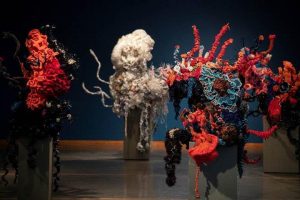Taking place in the summer of 2020, Helsinki Biennial is thrilled to announce the 40 artists and groups of artists participating in the inaugural edition, The Same Sea. Located on Vallisaari, an island in the Baltic Sea, the biennial presents over 75% new commissions and site-specific works, sensitively positioned across this remarkable maritime setting. Responding to, whilst safeguarding, Vallisaari’s natural environment, The Same Sea reflects upon the ever-pressing notion of interdependence.
Curators Pirkko Siitari and Taru Tappola, head curators of Helsinki Art Museum (HAM), invite a dialogue between artists and collectives from Finland and Australia, Cambodia, Germany, India, Japan, Kenya, Latvia, Poland, South Korea, Thailand, Turkey, the UK and the USA.
Welcoming both locals and visitors, this major moment in Helsinki’s cultural trajectory affirms its position as a city of arts and culture; “Art and culture form an essential part of Helsinki’s story. We recognise how investment in the arts positively adds to the development of the city, but also directly to the wellbeing of our citizens. Helsinki Biennial will both provoke and inspire audiences by confronting significant global issues. Its location on an island creates a truly unique setting where the art is in continuous dialogue with the surrounding nature, and importantly it is open, free of charge, to everyone,” says the mayor of Helsinki, Jan Vapaavuori.
The Helsinki Biennial 2020 participants include:
Paweł Althamer, ATTAKWAD, Pasi Autio, Samir Bhowmik, BIOS Research Unit, Baran Caginli, Janet Cardiff and George Bures Miller, Kyungwoo Chun, Janet Echelman, EGS, Katharina Grosse, Gustafsson&Haapoja, Hanna Tuulikki, Honkasalo-Niemi-Virtanen, IC-98, Uwa Iduozee, Wanuri Kahiu, Marja Kanervo, Topi Kautonen, Khvay Samnang, Jussi Kivi, Alicja Kwade, Hayoun Kwon, Laura Könönen, Tuomas A. Laitinen, Teemu Lehmusruusu, Dafna Maimon, Antti Majava, Inga Meldere, Jaakko Niemelä, Meiju Niskala, Niskanen & Salo, Sari Palosaari, Outi Pieski, Birit and Katja Haarla, Mario Rizzi, Rirkrit Tiravanija & Antto Melasniemi, Christine and Margaret Wertheim, Maaria Wirkkala, Tadashi Kawamata, and Zodiak presents: Joni Kärkkäinen & Jukka Tarvainen.
New commissions embrace diverse themes ranging from relations to nature, borders, identities, human traces, time and empathy. As a physical manifestation of interconnectedness, Jaakko Niemelä’s large-scale wooden construction Quay 6 greets visitors as they disembark at the northern quay of Vallisaari. Referencing the melting of Greenland’s northern ice sheet, the construction reaches six metres high – mirroring the rise in sea level should the glacier vanish completely.
Christine and Margaret Wertheim bring their Crochet Coral Reef project to Helsinki, The Helsinki Satellite Reef, one of the world’s largest participatory science and art projects. Made of recycled plastic, including disused plastic bags, the handmade reef is created with residents of Helsinki, calling attention to the extensive plastic waste threatening the world’s oceans.
Other commissions have also involved local Helsinki communities, such as Paweł Althamer’s collaboration with the nearby Suomenlinna Open Prison for Seven Prisoners; a two-part documentary and VR film which invites viewers to join seven inmates (including Althamer himself) on an escape from prison, via open waters and changing, seasonal landscapes.
Utilising recycled materials, Tadashi Kawamata’s Vallisaari Lighthouse is a temporary landmark comprised of found material from Vallisaari. Sitting atop a bunker-like elevator shaft, jutting skywards to a height of several metres, the lighthouse can be seen from various viewpoints out at sea, the neighbouring island of Suomenlinna and the Helsinki waterfront.
Marja Kanervo’s work similarly draws from the island’s existing infrastructure. Working on-site across three floors of Block A of the Pilot House, Kanervo’s site-specific interventions – forms and marks imprinted across the space – merge with the traces of former residents, straddling the space between real life and fiction.
Positioned outside of the Alexander Battery – one of the main biennial venues – Laura Könönen’s large-scale sculpture depicts an explosion of broken shards of rock. Appearing as though the structures were at one point a complete solid, the work forces us to revisit our ideas of stability and permanence. The sculpture forms part of the larger work No Heaven up in the Sky, which will be placed on permanent display in Helsinki’s Hyväntoivonpuisto Park after 2020.
Katharina Grosse’s large-scale, in-situ painting masks the exterior walls of Vallisaari’s former school building, converging with the surrounding landscape. Rather than a conventional painting, the result of Grosse’s painting process is more like a sculpture that emerges from a geographical location.
Echoing Helsinki Biennial’s commitment to inspiring public debate around the relationship between humanity and nature, the BIOS Research Unit will establish the Vallisaari Research Station within the island’s former fire-fighting depot. Hosting seminars and lectures from visiting scientists throughout the biennial, BIOS’ project specifically focuses on the lost, severed connection between the environment and the economy.
Uniting the maritime island with the city, Helsinki Biennial also extends its presence to the mainland; works by EGS, Janet Echelman, Rirkrit Tiravanija & Antto Melasniemi and Zodiak, as well as a solo exhibition from Gustafsson&Haapoja at HAM (3 April–16 August 2020), will be complemented by a special collaboration with the Facebook Art Department. Moreover, throughout the summer a programme of exhibitions, events, workshops and educational activities take the form of Helsinki Biennial Inspired.


